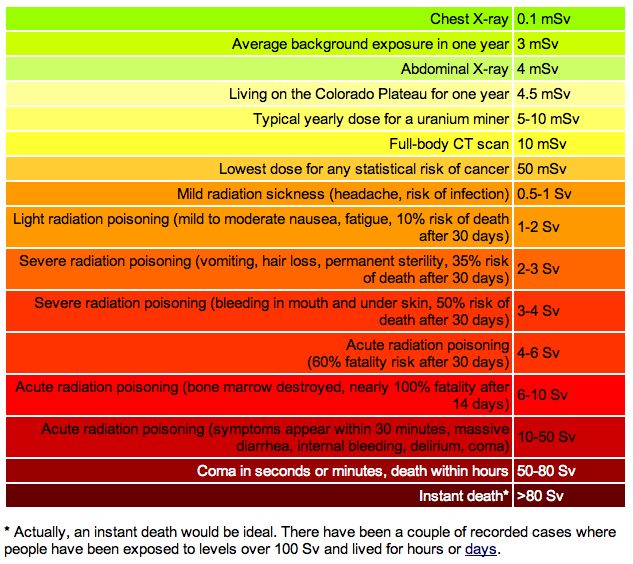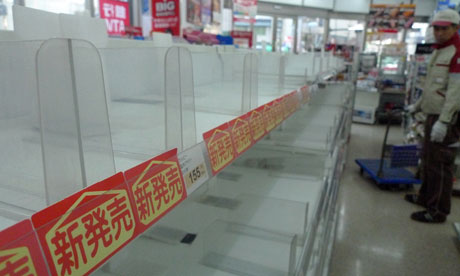So that stops any pictures of the damage from the air reaching us.Japan has imposed a no-fly zone over Fukushima Daiichi nuclear plant due to detected radiation, the country's transportation ministry announced.
Nuclear accident follows Japanese earthqauke
Moderator: Peak Moderation
- biffvernon
- Posts: 18538
- Joined: 24 Nov 2005, 11:09
- Location: Lincolnshire
- Contact:
-
2 As and a B
- Posts: 2590
- Joined: 28 Nov 2008, 19:06
I'll bet EDF are glad they aren't TEPCO, and hoping they don't become like TEPCO.
http://markets.ft.com/tearsheets/perfor ... 0176962806 TEPCO share price down 50% so far this week.
http://markets.ft.com/tearsheets/perfor ... 0176962806 TEPCO share price down 50% so far this week.
Forbes blog“In addition to the reactor cores, the storage pool for highly radioactive irradiated nuclear fuel is also at risk. The pool cooling water must be continuously circulated. Without circulation, the still thermally hot irradiated nuclear fuel in the storage pools will begin to boil off the cooling water. Within a day or two, the pool’s water could completely boil away. Without cooling water, the irradiated nuclear fuel could spontaneously combust in an exothermic reaction. Since the storage pools are not located within containment, a catastrophic radioactivity release to the environment could occur. Up to 100 percent of the volatile radioactive Cesium-137 content of the pools could go up in flames and smoke, to blow downwind over large distances. Given the large quantity of irradiated nuclear fuel in the pool, the radioactivity release could be worse than the Chernobyl nuclear reactor catastrophe of 25 years ago.”
-
Aurora
Latest from IAEA:
A radiation chart is available to view here: http://nextbigfuture.com/2011/03/radiation-chart.html
400 millisievert per hour. Let's put that into perspective.Japan Earthquake Update (15 March 2011, 06:15 CET)
Japanese authorities informed the IAEA that there has been an explosion at the Unit 2 reactor at the Fukushima Daiichi plant. The explosion occurred at around 06:20 on 15 March local Japan time.
Japanese authorities also today informed the IAEA at 04:50 CET that the spent fuel storage pond at the Unit 4 reactor of the Fukushima Daiichi nuclear power plant is on fire and radioactivity is being released directly into the atmosphere.
Dose rates of up to 400 millisievert per hour have been reported at the site. The Japanese authorities are saying that there is a possibility that the fire was caused by a hydrogen explosion.
Article continues ...
A radiation chart is available to view here: http://nextbigfuture.com/2011/03/radiation-chart.html
- biffvernon
- Posts: 18538
- Joined: 24 Nov 2005, 11:09
- Location: Lincolnshire
- Contact:
Er, right, anyone fancy a go at interpreting that.Aurora wrote:400 millisievert per hour. Let's put that into perspective.
A radiation chart is available to view here: http://nextbigfuture.com/2011/03/radiation-chart.html
Presumably these radiation measurements are gamma rays and nothing to do with particles that might be alpha emitters and could be scattered to the four winds when explosions next to spent fuel rods occur.
- biffvernon
- Posts: 18538
- Joined: 24 Nov 2005, 11:09
- Location: Lincolnshire
- Contact:
Still no recent images of Fukushima Daiichi - no video, no photo, no sat image - that would show explosion at reactor #2 or fire at #4. Seems cooling pumps for #4 were diverted to 1,2,&3 leaving spent fuel at 4 to get hot, evolve hydrogen and catch fire. 8 metre hole blown in building.
The lack of pics may be explained by this tweet:
Do planes really stir up the atmosphere that much? I just find this a bit strange.Japan also announced a 30-km no-fly zone around the reactors to prevent planes spreading the radiation further afield.
The lack of pics may be explained by this tweet:
The press have gone away without even leaving a webcam behind! How likely is that?photographer friend just called from Fukushima area. all media is gone. but local people have no way to leave. very sad
-
Aurora
The Guardian - 15/03/11
Japan's nuclear emergency prompts panic buying in Tokyo
Article continues ...
-
2 As and a B
- Posts: 2590
- Joined: 28 Nov 2008, 19:06
biffvernon wrote:Er, right, anyone fancy a go at interpreting that.Aurora wrote:400 millisievert per hour. Let's put that into perspective.
A radiation chart is available to view here: http://nextbigfuture.com/2011/03/radiation-chart.html

Doesn't it depend on how long the exposure is? Stand around in it for 1¼ hours and you can expect mild radiation sickness. That would severely limit the ability of the technicians to do whatever they need to do to make the area 'safe'. Unless there is an unlimited supply of technicians.
Yes, doesn't the toxicity rather depend on what the radioactive elements are. Radionuclides of strontium, caesium and iodine can be absorbed by the body and hang around releasing their radioactivity over weeks or years.biffvernon wrote:Presumably these radiation measurements are gamma rays and nothing to do with particles that might be alpha emitters and could be scattered to the four winds when explosions next to spent fuel rods occur.
-
2 As and a B
- Posts: 2590
- Joined: 28 Nov 2008, 19:06
Bbc website rolling news:
1228: France's nuclear safety authority says it classifies the Fukushima plant accident as level six. The maximum is level seven, used only once for the 1986 Chernobyl accident, Reuters reports.
1226: German flag-carrier Lufthansa says it is diverting all Tokyo-bound flights to other Japanese cities until at least Sunday, Agence France Press reports.
1221: Wondering what the world's press is writing about what this crisis means for the future of nuclear power? You'll find a round-up here.
1214: Mayu Iwakami, a resident of a suburb of Sendai, tells the BBC World Service that her and her family and neighbours are "try[ing] not to be in a state of hysteria until we actually get the information regarding radiation and a possible evacuation. Until then, we try to keep calm and carry on."
- adam2
- Site Admin
- Posts: 10893
- Joined: 02 Jul 2007, 17:49
- Location: North Somerset, twinned with Atlantis
Some mainstream media seem rather confused as to the measurement of radiation.
The accepted unit unit is the Seivert.
This is a large unit.
One sievert is likely to cause illness
4 sieverts can kill
10 Sieverts are likely to kill
Lower levels are normally measured in milli-sieverts, one thousandth of a sievert, or in microsieverts, one millioneth of a sievert.
normal or background levels of radiation are typicly measured in millisieverts per year. Background levels in the UK vary according to location, but are normally reckond to be about 2.4 millisieverts a year.
This is about 0.27 microsieverts an hour.
In Central London I have just measured a level of about 0.2 microsieverts an hour, which is entirely normal.
After the Chernobyl accident I found the level in London to be about 3 times normal background at about 0.7 microsieverts an hour, and in Wales to be higher still at about 1 microsievert an hour.
The accepted unit unit is the Seivert.
This is a large unit.
One sievert is likely to cause illness
4 sieverts can kill
10 Sieverts are likely to kill
Lower levels are normally measured in milli-sieverts, one thousandth of a sievert, or in microsieverts, one millioneth of a sievert.
normal or background levels of radiation are typicly measured in millisieverts per year. Background levels in the UK vary according to location, but are normally reckond to be about 2.4 millisieverts a year.
This is about 0.27 microsieverts an hour.
In Central London I have just measured a level of about 0.2 microsieverts an hour, which is entirely normal.
After the Chernobyl accident I found the level in London to be about 3 times normal background at about 0.7 microsieverts an hour, and in Wales to be higher still at about 1 microsievert an hour.
"Installers and owners of emergency diesels must assume that they will have to run for a week or more"
-
Aurora
Reuters - 15/03/11
The operator of Japan's earthquake-stricken nuclear power plant may pour water by helicopter to cool a spent-fuel pool in a reactor within two or three days, the plant operator said.
Tokyo Electric Power Co may pour the water in the building housing the No.4 reactor at the Fukushima Daiichi nuclear plant, a company official told a news conference.
A blast earlier punctured two holes in the wall of the outer building of the reactor, exposing the nuclear spent fuel pool to the outside air.
Japan is facing a potential catastrophe after cooling problems and explosions at the Fukushima plant, which released low levels of radiation that the wind could carry to Tokyo.
Original Article
- Mean Mr Mustard
- Posts: 1555
- Joined: 31 Dec 2006, 12:14
- Location: Cambridgeshire
Aurora wrote:May I recommend the Mil 26 Halo?Reuters - 15/03/11
The operator of Japan's earthquake-stricken nuclear power plant may pour water by helicopter to cool a spent-fuel pool in a reactor within two or three days, the plant operator said.
Nuclear mishaps and accident-clean-up ops proven, stonkingly large Soviet helicopter...
1855 Advertisement for Kier's Rock Oil -
"Hurry, before this wonderful product is depleted from Nature’s laboratory."
The Future's so Bright, I gotta wear Night Vision Goggles...
"Hurry, before this wonderful product is depleted from Nature’s laboratory."
The Future's so Bright, I gotta wear Night Vision Goggles...



